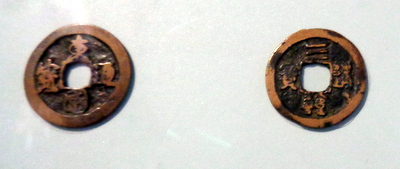Difference between revisions of "Korean currency"
From SamuraiWiki
Jump to navigationJump to search (Created page with " The earliest Korean coins were minted and circulated for about one hundred years, from about the 990s to around 1105. Based on Tang Dynasty Chinese currency, the coin...") |
|||
| Line 1: | Line 1: | ||
| + | [[File:Koreancoins.jpg|right|thumb|400px|Two 10th-11th c. coins from [[Goryeo]], imprinted ''Dongguk'' and ''Samhan''. British Museum.]] | ||
The earliest Korean coins were minted and circulated for about one hundred years, from about the 990s to around 1105. Based on [[Tang Dynasty]] [[Chinese currency]], the coins were imprinted with terms including ''Haedong'' ("[[Sea of Japan|East Sea]]"), ''Samhan'' ("[[Three Kingdoms (Korea)|Three Kingdoms]]"), and ''Dongguk'' ("Eastern Kingdom"). | The earliest Korean coins were minted and circulated for about one hundred years, from about the 990s to around 1105. Based on [[Tang Dynasty]] [[Chinese currency]], the coins were imprinted with terms including ''Haedong'' ("[[Sea of Japan|East Sea]]"), ''Samhan'' ("[[Three Kingdoms (Korea)|Three Kingdoms]]"), and ''Dongguk'' ("Eastern Kingdom"). | ||
Revision as of 09:26, 7 July 2017

Two 10th-11th c. coins from Goryeo, imprinted Dongguk and Samhan. British Museum.
The earliest Korean coins were minted and circulated for about one hundred years, from about the 990s to around 1105. Based on Tang Dynasty Chinese currency, the coins were imprinted with terms including Haedong ("East Sea"), Samhan ("Three Kingdoms"), and Dongguk ("Eastern Kingdom").
Such coins have mainly been found in excavations at Kaesong, the capital of Goryeo, and do not seem to have circulated widely to/in other parts of the peninsula.
References
- British Museum gallery labels.[1]